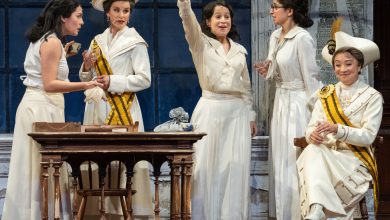Victory Speech (Hillary’s Version)

MasterClass, an online platform where you can watch famous people deliver video tutorials for $180 a year, recently debuted a course on the topic of resilience. It begins with a close-up shot of a weathered oval desk. We hear papers shuffling, birds chirping, the voices of an ethereal choir. A woman’s hands drift across a policy document. As white light flares through a garden window, Hillary Clinton appears. She wears a serene smile and a magenta blouse. It feels like she’s back from the dead.
Clinton’s 16 video lessons in resilience are largely tedious (one is about binder organization), but the whole exercise builds to a rattling unease. The course culminates with Clinton reciting her unused presidential victory speech from 2016. Holding the text in her lap like a storybook, she seems to be impersonating a lost version of herself. She is accessing a faintly smug, terribly naïve Hillary Clinton, as if practicing in front of a mirror for a moment that would never arrive. It’s the kind of humiliating growth exercise you might spy through the keyhole of a therapist’s office. Even as Clinton has styled herself as an influencer on the subject of carrying on, it feels as if she is being held hostage by the past, compelled to relive her defeat again and again.
This is, actually, a very 2021 way to be. Popular culture is saturated with famous figures playing their past selves, revisiting old haunts and resurrecting buried personal histories. This year, Taylor Swift began releasing note-for-note re-recordings of her early albums in a bid to reclaim control of her catalog after her adversary Scooter Braun assumed ownership of her masters and sold them to an investment fund. The cast of “Friends” reunited in an eerie replica of Central Perk, while the original “Real World” roommates returned to the Manhattan loft they shared in 1992. And celebrities have flooded TikTok, groveling to fans with corny re-enactments: Ryan Reynolds poorly lip-syncs a bit from his 2005 rom-com “Just Friends,” while Zooey Deschanel eagerly replicates her song and dance from the “New Girl” opening credits.
I thought we had reached peak pop culture nostalgia a decade ago, when an endless buffet of 1990s-kid ephemera was rewarmed for digital consumption and a sepia Instagram filter could convert last night’s party photos into an instant retrospective. But there is something unexpectedly charged about this development, which invites us to watch a person squeeze back into her old skin. The literalness of the exercise emphasizes the slipperiness of time, shining a garish spotlight on mortality and lending a tragic depth to the most venal of reunion specials. Even the cringey TikToks have a measure of profundity, as aging celebrities play their younger selves to appeal to even younger audiences, all set on a perpetual loop.
The imperative of the streaming boom is to turn the content spigot to full blast, but that makes content seem forgettable and cheap. So now producers are resurrecting properties from when content was scarce enough to feel precious, and inviting us to watch as the associated celebrities reinfuse them with their auras. Like the doomed characters on “Lost,” who manage to escape their spooky island only to feel compelled to return, the financial pull of existing I.P. is often too strong for famous people to resist. These re-enactments and self-impersonations represent the latest turn in the entertainment industry’s rapacious churn, as it mines psychodrama from the very process of rebooting culture.
It all reminds me of a different kind of re-enactment: this year’s documentary “Procession,” which concerns six men who survived child sexual abuse in the Catholic Church. With the help of a drama therapist and the documentarian Robert Greene, they revisit the scenes of the crimes, act out fictionalized versions of their memories and film them. One of the men recreates a priest’s quarters, paints it all white, then destroys it with a sledgehammer; another hunts down a priest’s old lake house and walks the overgrown path that led to his rape. Their hope is that by physicalizing these traumatic incidents, they can reinscribe their memories and dispel their power.
These Hollywood re-enactments also have a sheen of exposure therapy, conjuring old dramas through sense memory. “Friends: The Reunion,” on HBO Max, emphasizes the production’s precise rebuilding of sets, and as soon as Jennifer Aniston crosses the threshold of the replicated apartment of her character, Rachel Green, tears are in her eyes. Later, she would say that she was so walloped by memories — the end of “Friends” overlapped with the dissolution of her marriage to Brad Pitt — that she paused filming to pull herself together. Aniston’s tabloid persona is haunted by her past romantic lives, and the scenario felt designed to rouse dormant narratives. Part of the lurid appeal of the reunion is watching the lightly debasing spectacle of the cast assembling around a table to re-enact old scripts, as if in a celebrity support group for exorcising classic roles. Of course, the actual purpose is to prime viewers to revisit their own ’90s memories, via “Friends” episodes, which are now exclusively streaming on HBO Max.
On “The Real World: Homecoming,” on Paramount+, the frisson of the reunion springs from their reoccupation of the loft they shared nearly 30 years ago. The housemates have hardly popped a bottle of prosecco when a tense 1992 argument about racism between Becky, a white songwriter, and Kevin, a Black activist, is replayed for the group. The cast seems prepared to calmly reprocess this exchange with the exception of Becky (now an alternative healer who goes by Rebecca), who instantly springs back to her familiar defensive posture, protesting that she “lost” her “skin color” through her experience dancing with a multiethnic troupe. So strong is the psychological pull of this place, she becomes convinced that she was actively set up as the scapegoat for white privilege, and she scurries from the loft for good.
This messy display stands in contrast to Taylor Swift’s tightly controlled nostalgic exercise. Her re-recordings are deliberately unrevealing — she sounds as if she is performing uncanny self-karaoke — but the story she has spun around them is captivating. In April, she released “Fearless (Taylor’s Version),” a rerecording of her 2008 album. On it, we hear a 31-year-old woman impersonating her 19-year-old self reflecting on her 15-year-old self, and doing it all to smite the men who hoped to seize control of her songs.
For a time, the most indelible cultural artifact of this moment was a parenthetical bit of metadata, “(Taylor’s Version),” which Swift appended to the titles of her newly recorded songs, and which became a meme anyone could use to signal a prideful ownership of their own cultural outputs, no matter how slight. But in November, Swift’s immersion in her past built to a breakthrough, as she released a 10-minute extension of her beloved 2012 breakup song “All Too Well.” With the new version, she interpolates the wistful original with starkly drawn scenes that play almost like recovered memories, recasting a romance as a site of trauma that so reduced her that she compares herself to “a soldier who’s returning half her weight.”
Nostalgia is derived from the Greek words for “homecoming” and “pain,” and before it referred to a yearning for the past, it was a psychopathological disorder, describing a homesickness so severe it could actually kill. Nostalgia itself represented a form of traumatic stress, and now pseudo-therapeutic treatments have made their way into our cultural retrospectives. So while Serena Williams appears on MasterClass to teach tennis, and Ringo Starr to teach drumming, Clinton arrives to school us on “the power of resilience.”
Resilience suggests elasticity, and there is something morbidly fascinating about watching Clinton revert to her pre-Trump form. The victory speech itself reads like centrist Mad Libs — a meditation on “E Pluribus Unum,” nods to both Black Lives Matter and the bravery of police, an Abraham Lincoln quote — but at its end it veers into complex emotional territory. Clinton recalls her mother, Dorothy Rodham, who died in 2011, and as she describes a dream about her, her voice shakes and warps in pitch. Dorothy Rodham had a bleak upbringing, and Clinton wishes she could visit her mother’s childhood self and assure her that despite all the suffering she would endure, her daughter would go on to become the president of the United States.
As Clinton plays her former self comforting her mother’s former self with the idea of a future Clinton who will never exist, we finally glimpse a loss that cannot be negotiated, optimized or monetized: She can never speak to her mother again. Soon, Clinton’s MasterClass has reverted back to its banal messaging — she instructs us to dust ourselves off, take a walk, make our beds — but for a few seconds, she could be seen not as a windup historical figure but as a person, like the rest of us, who cannot beat time.





